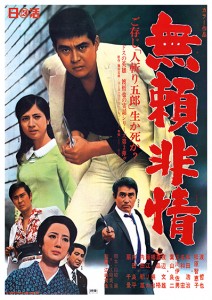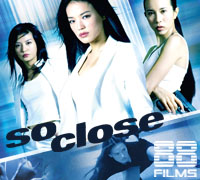AKA: Gangster VIP 3
Director: Mio Ezaki
Producer: Kaneo Iwaib
Cast: Tetsuya Watari, Chieko Matsubara, Ryohei Uchida, Koji Wada, Hiroshi Nawa, Isao Tamagawa, Eiji Go, Ryoji Hayama, Fumio Watanabe, Kaku Takashina, Asao Uchida
Running Time: 92 min.
Kelly Warner
For me, Outlaw: Heartless is a difficult film to figure out. Viewed purely on its own terms, it’s an entertaining crime pic with a cool antihero leading a cast of interesting characters. But viewed as the third film in the Outlaw series of gangster movies… it’s kind of odd. It also might be a prequel. Or maybe not? More on that later.
In Japanese cinema, it’s not uncommon for actors to reappear in subsequent films playing different characters. That happens here in a most peculiar way. In the first two films, Chieko Matsubara played the main character’s love interest, a naïve and rather clingy young woman named Yukiko who doesn’t want to return home. In Heartless, Chieko Matsubara plays the main character’s love interest, a naïve and rather clingy young woman named Keiko who can’t return home. Though they’re given different names and slightly different backstories, they’re basically the same character played by the same actress and given the same role in the story. It’s bizarre. I’ve seen sequels that attempt to give us ‘the new girl’ which is basically Love Interest 2.0 but they’re usually (always?) played by different actresses. And I’ve seen sequels where the actor returns in a different part, but that part is often a big changeup from the one they played last time. I’ve never seen anything quite like this before and some part of me feels like they broke an unwritten rule. I mean, when Chieko Matsubara showed up in the film, I naturally thought, ‘Oh good, Yukiko’s back! You know, I’m starting to like her.’ Only then the film makes it clear that she’s not Yukiko, she’s someone named Keiko, a girl that we’ve never met before. Now watch as she acts just like Yukiko as we reboot the romance that was finally starting to get somewhere. It’s so strange to me.
Outlaw: Heartless has a more negative view of the yakuza world than the first two films did—which is something, considering Gangster VIP and VIP 2 don’t exactly celebrate the criminal lifestyle. The yakuza of Heartless are… well, heartless. They’re bastards who attack sick women, betray close confidants, and care little for the bonds of family. Goro (Tetsuya Watari) is a different breed. In a moody opening scene, Goro is sent to collect money from a downtrodden yakuza that is holding onto a bundle of money to help his sick wife. While Goro would prefer to threaten and perhaps rough up the guy to get what he wants, the thugs with Goro have no issue stabbing the man to death. With his dying words, the yakuza asks Goro to take his wife to Yokohama. Goro agrees to do so, but not before pissing off the gang he was working for, thus making him a marked man. When he makes it to Yokohama with the sick woman in tow, Goro bumps into an old friend (Ryohei Uchida) and meets a young woman (Matsubara), and the two attempt to convince him to give up the yakuza life and go straight. (Ryohei Uchida is another notable returning actor playing a different part. But unlike Matsubara, Uchida is given a very different role to play. Uchida was the villain of Gangster VIP 2 and in Heartless he’s the friend that Goro’s trying to keep at an arm’s length so that he doesn’t get hurt. Uchida plays both villain and reliable friend quite well.)
Though Goro means well, he brings death and destruction wherever he goes. Goro begins to understand this and tries to distance himself from his friends, even going so far as offending them in hopes that they won’t want anything more to do with him. Though he makes an attempt of going straight, old enemies follow him everywhere and he has a tendency of pissing off yakuza wherever he goes.
Outlaw: Heartless could’ve lifted its story directly out of a Zatoichi film and transplanted it into 1950’s Japan without skipping a beat. Goro is essentially the modern equivalent of the wandering swordsman antihero of so many Japanese film series. That’s not to say it’s a been-there-done-that kind of story, though. With the exception of needlessly trying to reboot the love interest role, the story of Heartless feels rather fresh, especially compared to Gangster VIP 2 which sought to repeat the success of the first film by doing it all over again. There’s a small-town quality to Heartless that I liked, which is partly thanks to taking the story from Tokyo to Yokohama. And I enjoyed how one good deed leaves so many dead by the end (one of the film’s best lines refers to using a bundle of cash to pay for all the funerals). Though colorful and fast-paced, Heartless is the most downbeat Outlaw film so far.
The film also works as a standalone effort. Actually, considering my issues with the Chieko Matsubara character, perhaps Outlaw: Heartless works best as a standalone. Though it never makes it abundantly clear either way, Heartless seems to be a prequel. It makes no mention of the stories from the first two films and seems to depict Goro as a man who’s still figuring himself out. If it is indeed a prequel, then it’s a prequel in the way that Indiana Jones and the Temple of Doom is a prequel—yes, it may have happened first, but it doesn’t seem to have an impact on the overarching story either way.
Outlaw: Heartless is the only film in the series directed by Mio Ezaki. I must confess that I’m totally unfamiliar with the director. He seems to have done most of his work in TV. However, just because he’s unknown doesn’t mean he’s unskilled. Ezaki makes good use of color throughout the film, which is something I’ll always cheer for in this, the age of desaturated film. It’s no accident then that the film’s big action finale takes place in a paint warehouse, with overturned paint cans spilling everywhere, splashing the brawling men in all the colors of the rainbow. It’s a sequence reminiscent of the finale in Akira Kurosawa’s Drunken Angel, a black and white film that also had its yakuza slipping through paint as they fought to the death. The effect is more striking here thanks to the color photography, though it ends up looking much the same as Kurosawa’s early classic as the colors mix together and turn into a gray muck.
I have some issues with Outlaw: Heartless. The fact that the film decided to make a spiritual clone of Yukiko and cast the same actress in the role just bugs the hell out of me. I don’t get it. But other than that it’s a pretty good film! So, I’m torn on how to rate this thing. I know that others will be more forgiving to the film’s peculiar casting decision, just as I know that others will be even more confused than I was… Ah hell, I’m throwing up my hands and giving it a 7. Far from perfect and sometimes downright baffling, Outlaw: Heartless is still an entertaining film that I’d be happy to watch again.
Kelly Warner’s Rating: 7/10





lol the whole casting/different character thing reminds me of the Lucky Stars series: All, pretty much have the same cast – many of the returning cast members appear to be the same person, personality and visually speaking – but then the next thing you realize, they’re playing someone else! This can also be compared to the whole Joe Don Baker (The Living Daylights/Goldeneye) ‘n Maud Adams (Man with the Golden Gun/Octopussy) thing as well. I also learned something new: I never knew Indiana Jones and the Temple of Doom was a prequel!
I believe Temple of Doom takes place in 1935 while Raiders of the Lost Ark is 1936. The only issue I have with its “prequel” status is that it ruins Temple’s gun vs. sword gag, especially if you watch Temple first. You know the part in Raiders where the swordsman is showing off his skills and Indy just draws down and shoots him? In Temple he finds himself in a similar situation, only the gun’s not in his holster, so Indy just smiles. It’s a wink to the audience that doesn’t work if you consider that this story supposedly happened first… And that’s me over-analyzing a silly joke in an otherwise entertaining adventure film!
Yeah, I remember both of those scenes. Well, release date-wise, it makes total sense; and that’s the only context that matters when it comes to that sword/gun scene.
I wonder why they made it a prequel, which place before Raiders. Unless there’s some significant event or date I failed to recognize. I really have to watch this series all over again. Its been aw while. And I haven’t even seen the latest one (the one with your buddy, Shia LaBeouf)
What happens here with Chieko Matsubara was not entirely rare in 1960s Japanese cinema. The hugely popular Abashiri Prison series is a good example. Kanjuro Arashi and Kunie Tanaka both played the same characters throughout the series, except in some films they were technically speaking different characters with a different name, but the exact same personality. It was a bit confusing indeed, especially when a character got killed in an earlier film and you never realized it was a “different” character.
I believe Japan’s kaiju films were the first time I’d seen actors return to a series time and again to play different characters each time. In my youth, I thought it was strange. Now it’s just a part of the appeal, I guess. The same goes for other Japanese films of the time, like countless samurai and gangster flicks. I’ve still never seen the Abashiri Prison films. I’ll have to keep what you said in mind when I finally get the chance to see them!
It’s something which happens even today. The most obvious example being Yayan Ruhian’s roles in ‘The Raid’ & ‘The Raid 2’.
True. And I have no real issue with directors deciding to bring a cast member back in a different role. But Yayan Ruhian’s parts in The Raid films are two very different characters. There’s no confusing them once the story establishes that they’re meant to be different people, despite the fact that Yayan looks pretty much the same in both films (he brings so much to both films that I’d be happy to see him play a third character in The Raid 3). It’s sort of like Tatsuya Nakadai playing two different villainous ronin in Yojimbo and the sequel Sanjuro. Or Garret Dillahunt returning as a different character in HBO’s Deadwood. Or more recently, Alfre Woodard playing two different parts in the Marvel Cinematic Universe. And many more. The point I was trying to make is how similar the Chieko Matsubara characters are to one another, going so far as to recreate some of the same romantic moments with the Goro character. I find that it can be momentarily confusing to see an actor return in a different part, but that confusion lingers much longer when the new character so closely resembles the old one.
Yeah, it’s kinda weird and kinda wish she just played the same character as there would have been some growth.
Somewhat spoilers for the upcoming films. In one of the upcoming films she plays TWO characters who are identical. Yup, TWO and they are exactly alike! It’s only going to get more confusing.